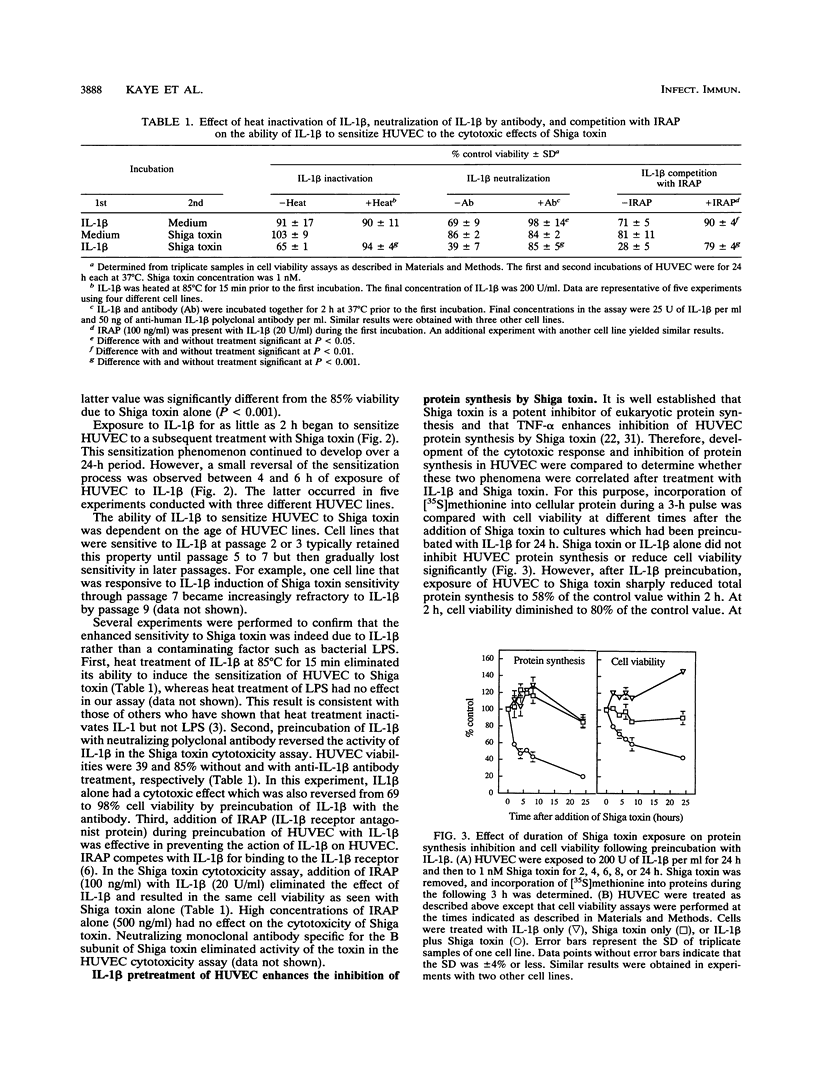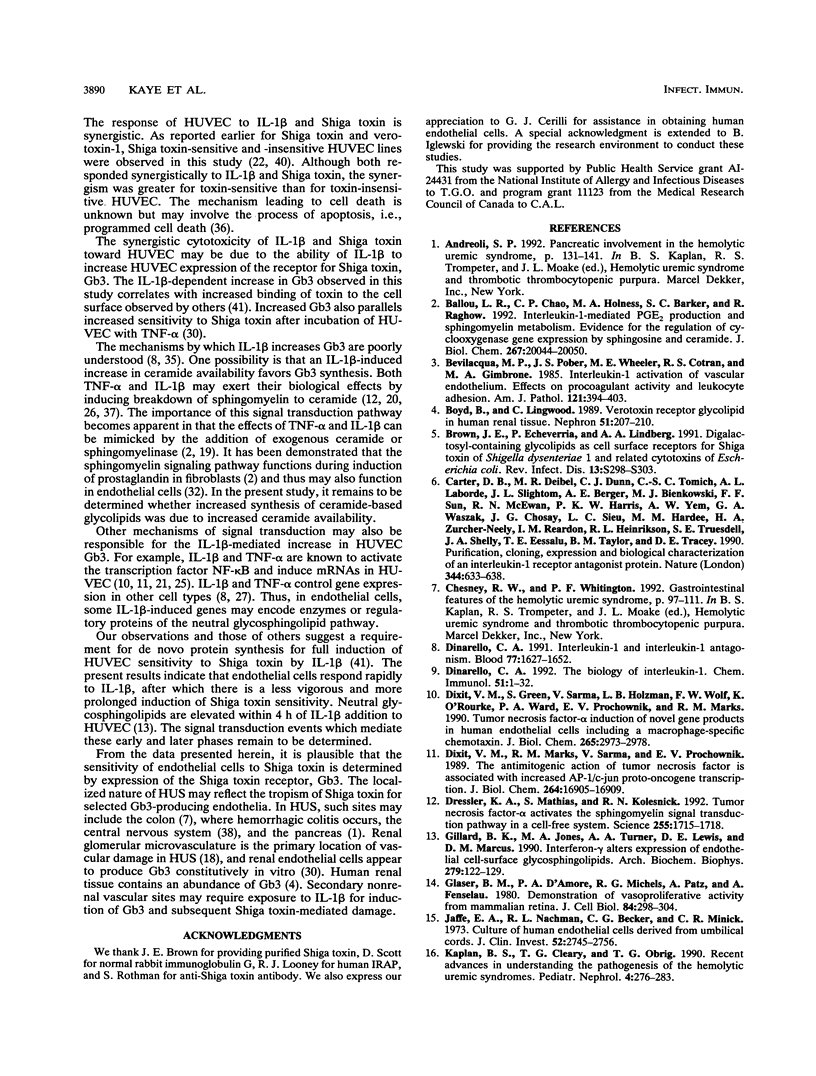Abstract
Development of hemolytic uremic syndrome (HUS) after infection by Shigella dysenteriae 1 or enterohemorrhagic Escherichia coli has been associated with the production of Shiga toxins (verotoxins). The putative target of Shiga toxins in HUS is the renal microvascular endothelium. This report shows that preincubation of human umbilical vein endothelial cells (HUVEC) with interleukin-1 beta (IL-1 beta) enhances the cytotoxic potency of Shiga toxin toward HUVEC. A preincubation of HUVEC with IL-1 beta is required for sensitization of HUVEC to Shiga toxin. Sensitization of HUVEC to Shiga toxin is IL-1 beta dose dependent. Development of the IL-1 beta response is time dependent, beginning within 2 h of IL-1 beta preincubation and increasing over the next 24 h. That these responses were due to IL-1 beta was demonstrated by heat inactivation of IL-1 beta, by neutralization of IL-1 beta by specific antibody, and by the ability of an IL-1 beta receptor antagonist to inhibit the effect of IL-1 beta. Shiga toxin-related inhibition of HUVEC protein synthesis preceded loss of cell viability. IL-1 beta incubation with HUVEC induced the receptor for Shiga toxin, globotriaosylceramide. Lipopolysaccharide included during IL-1 beta preincubation with HUVEC increased sensitivity to Shiga toxin in an additive manner. We conclude that IL-1 beta may induce Shiga toxin sensitivity in endothelial cells and contribute to the development of HUS.
Full text
PDF





Selected References
These references are in PubMed. This may not be the complete list of references from this article.
- Ballou L. R., Chao C. P., Holness M. A., Barker S. C., Raghow R. Interleukin-1-mediated PGE2 production and sphingomyelin metabolism. Evidence for the regulation of cyclooxygenase gene expression by sphingosine and ceramide. J Biol Chem. 1992 Oct 5;267(28):20044–20050. [PubMed] [Google Scholar]
- Bevilacqua M. P., Pober J. S., Wheeler M. E., Cotran R. S., Gimbrone M. A., Jr Interleukin-1 activation of vascular endothelium. Effects on procoagulant activity and leukocyte adhesion. Am J Pathol. 1985 Dec;121(3):394–403. [PMC free article] [PubMed] [Google Scholar]
- Boyd B., Lingwood C. Verotoxin receptor glycolipid in human renal tissue. Nephron. 1989;51(2):207–210. doi: 10.1159/000185286. [DOI] [PubMed] [Google Scholar]
- Brown J. E., Echeverria P., Lindberg A. A. Digalactosyl-containing glycolipids as cell surface receptors for shiga toxin of Shigella dysenteriae 1 and related cytotoxins of Escherichia coli. Rev Infect Dis. 1991 Mar-Apr;13 (Suppl 4):S298–S303. doi: 10.1093/clinids/13.supplement_4.s298. [DOI] [PubMed] [Google Scholar]
- Carter D. B., Deibel M. R., Jr, Dunn C. J., Tomich C. S., Laborde A. L., Slightom J. L., Berger A. E., Bienkowski M. J., Sun F. F., McEwan R. N. Purification, cloning, expression and biological characterization of an interleukin-1 receptor antagonist protein. Nature. 1990 Apr 12;344(6267):633–638. doi: 10.1038/344633a0. [DOI] [PubMed] [Google Scholar]
- Dinarello C. A. Interleukin-1 and interleukin-1 antagonism. Blood. 1991 Apr 15;77(8):1627–1652. [PubMed] [Google Scholar]
- Dinarello C. A. The biology of interleukin-1. Chem Immunol. 1992;51:1–32. doi: 10.1159/000319075. [DOI] [PubMed] [Google Scholar]
- Dixit V. M., Green S., Sarma V., Holzman L. B., Wolf F. W., O'Rourke K., Ward P. A., Prochownik E. V., Marks R. M. Tumor necrosis factor-alpha induction of novel gene products in human endothelial cells including a macrophage-specific chemotaxin. J Biol Chem. 1990 Feb 15;265(5):2973–2978. [PubMed] [Google Scholar]
- Dixit V. M., Marks R. M., Sarma V., Prochownik E. V. The antimitogenic action of tumor necrosis factor is associated with increased AP-1/c-jun proto-oncogene transcription. J Biol Chem. 1989 Oct 5;264(28):16905–16909. [PubMed] [Google Scholar]
- Dressler K. A., Mathias S., Kolesnick R. N. Tumor necrosis factor-alpha activates the sphingomyelin signal transduction pathway in a cell-free system. Science. 1992 Mar 27;255(5052):1715–1718. doi: 10.1126/science.1313189. [DOI] [PubMed] [Google Scholar]
- Gillard B. K., Jones M. A., Turner A. A., Lewis D. E., Marcus D. M. Interferon-gamma alters expression of endothelial cell-surface glycosphingolipids. Arch Biochem Biophys. 1990 May 15;279(1):122–129. doi: 10.1016/0003-9861(90)90471-a. [DOI] [PubMed] [Google Scholar]
- Glaser B. M., D'Amore P. A., Michels R. G., Patz A., Fenselau A. Demonstration of vasoproliferative activity from mammalian retina. J Cell Biol. 1980 Feb;84(2):298–304. doi: 10.1083/jcb.84.2.298. [DOI] [PMC free article] [PubMed] [Google Scholar]
- Jaffe E. A., Nachman R. L., Becker C. G., Minick C. R. Culture of human endothelial cells derived from umbilical veins. Identification by morphologic and immunologic criteria. J Clin Invest. 1973 Nov;52(11):2745–2756. doi: 10.1172/JCI107470. [DOI] [PMC free article] [PubMed] [Google Scholar]
- Kaplan B. S., Cleary T. G., Obrig T. G. Recent advances in understanding the pathogenesis of the hemolytic uremic syndromes. Pediatr Nephrol. 1990 May;4(3):276–283. doi: 10.1007/BF00857676. [DOI] [PubMed] [Google Scholar]
- Kim M. Y., Linardic C., Obeid L., Hannun Y. Identification of sphingomyelin turnover as an effector mechanism for the action of tumor necrosis factor alpha and gamma-interferon. Specific role in cell differentiation. J Biol Chem. 1991 Jan 5;266(1):484–489. [PubMed] [Google Scholar]
- Kolesnick R. N. Sphingomyelin and derivatives as cellular signals. Prog Lipid Res. 1991;30(1):1–38. doi: 10.1016/0163-7827(91)90005-p. [DOI] [PubMed] [Google Scholar]
- Krikos A., Laherty C. D., Dixit V. M. Transcriptional activation of the tumor necrosis factor alpha-inducible zinc finger protein, A20, is mediated by kappa B elements. J Biol Chem. 1992 Sep 5;267(25):17971–17976. [PubMed] [Google Scholar]
- Louise C. B., Obrig T. G. Shiga toxin-associated hemolytic uremic syndrome: combined cytotoxic effects of shiga toxin and lipopolysaccharide (endotoxin) on human vascular endothelial cells in vitro. Infect Immun. 1992 Apr;60(4):1536–1543. doi: 10.1128/iai.60.4.1536-1543.1992. [DOI] [PMC free article] [PubMed] [Google Scholar]
- Louise C. B., Obrig T. G. Shiga toxin-associated hemolytic-uremic syndrome: combined cytotoxic effects of Shiga toxin, interleukin-1 beta, and tumor necrosis factor alpha on human vascular endothelial cells in vitro. Infect Immun. 1991 Nov;59(11):4173–4179. doi: 10.1128/iai.59.11.4173-4179.1991. [DOI] [PMC free article] [PubMed] [Google Scholar]
- Maier J. A., Hla T., Maciag T. Cyclooxygenase is an immediate-early gene induced by interleukin-1 in human endothelial cells. J Biol Chem. 1990 Jul 5;265(19):10805–10808. [PubMed] [Google Scholar]
- Mathias S., Younes A., Kan C. C., Orlow I., Joseph C., Kolesnick R. N. Activation of the sphingomyelin signaling pathway in intact EL4 cells and in a cell-free system by IL-1 beta. Science. 1993 Jan 22;259(5094):519–522. doi: 10.1126/science.8424175. [DOI] [PubMed] [Google Scholar]
- Muegge K., Durum S. K. Cytokines and transcription factors. Cytokine. 1990 Jan;2(1):1–8. doi: 10.1016/1043-4666(90)90036-s. [DOI] [PubMed] [Google Scholar]
- Obrig T. G., Del Vecchio P. J., Brown J. E., Moran T. P., Rowland B. M., Judge T. K., Rothman S. W. Direct cytotoxic action of Shiga toxin on human vascular endothelial cells. Infect Immun. 1988 Sep;56(9):2373–2378. doi: 10.1128/iai.56.9.2373-2378.1988. [DOI] [PMC free article] [PubMed] [Google Scholar]
- Obrig T. G., Moran T. P., Brown J. E. The mode of action of Shiga toxin on peptide elongation of eukaryotic protein synthesis. Biochem J. 1987 Jun 1;244(2):287–294. doi: 10.1042/bj2440287. [DOI] [PMC free article] [PubMed] [Google Scholar]
- Pober J. S., Cotran R. S. Cytokines and endothelial cell biology. Physiol Rev. 1990 Apr;70(2):427–451. doi: 10.1152/physrev.1990.70.2.427. [DOI] [PubMed] [Google Scholar]
- Pudymaitis A., Lingwood C. A. Susceptibility to verotoxin as a function of the cell cycle. J Cell Physiol. 1992 Mar;150(3):632–639. doi: 10.1002/jcp.1041500324. [DOI] [PubMed] [Google Scholar]
- Riddell R. J., Clothier R. H., Balls M. An evaluation of three in vitro cytotoxicity assays. Food Chem Toxicol. 1986 Jun-Jul;24(6-7):469–471. doi: 10.1016/0278-6915(86)90095-5. [DOI] [PubMed] [Google Scholar]
- Saklatvala J., Guesdon F. Interleukin 1 and tumor necrosis factor signal transduction mechanisms: potential targets for pharmacological control of inflammation. J Rheumatol Suppl. 1992 Jan;32:65–70. [PubMed] [Google Scholar]
- Sandvig K., van Deurs B. Toxin-induced cell lysis: protection by 3-methyladenine and cycloheximide. Exp Cell Res. 1992 Jun;200(2):253–262. doi: 10.1016/0014-4827(92)90171-4. [DOI] [PubMed] [Google Scholar]
- Schütze S., Potthoff K., Machleidt T., Berkovic D., Wiegmann K., Krönke M. TNF activates NF-kappa B by phosphatidylcholine-specific phospholipase C-induced "acidic" sphingomyelin breakdown. Cell. 1992 Nov 27;71(5):765–776. doi: 10.1016/0092-8674(92)90553-o. [DOI] [PubMed] [Google Scholar]
- Tesh V. L., O'Brien A. D. The pathogenic mechanisms of Shiga toxin and the Shiga-like toxins. Mol Microbiol. 1991 Aug;5(8):1817–1822. doi: 10.1111/j.1365-2958.1991.tb00805.x. [DOI] [PubMed] [Google Scholar]
- Tesh V. L., Samuel J. E., Perera L. P., Sharefkin J. B., O'Brien A. D. Evaluation of the role of Shiga and Shiga-like toxins in mediating direct damage to human vascular endothelial cells. J Infect Dis. 1991 Aug;164(2):344–352. doi: 10.1093/infdis/164.2.344. [DOI] [PubMed] [Google Scholar]
- van de Kar N. C., Monnens L. A., Karmali M. A., van Hinsbergh V. W. Tumor necrosis factor and interleukin-1 induce expression of the verocytotoxin receptor globotriaosylceramide on human endothelial cells: implications for the pathogenesis of the hemolytic uremic syndrome. Blood. 1992 Dec 1;80(11):2755–2764. [PubMed] [Google Scholar]


